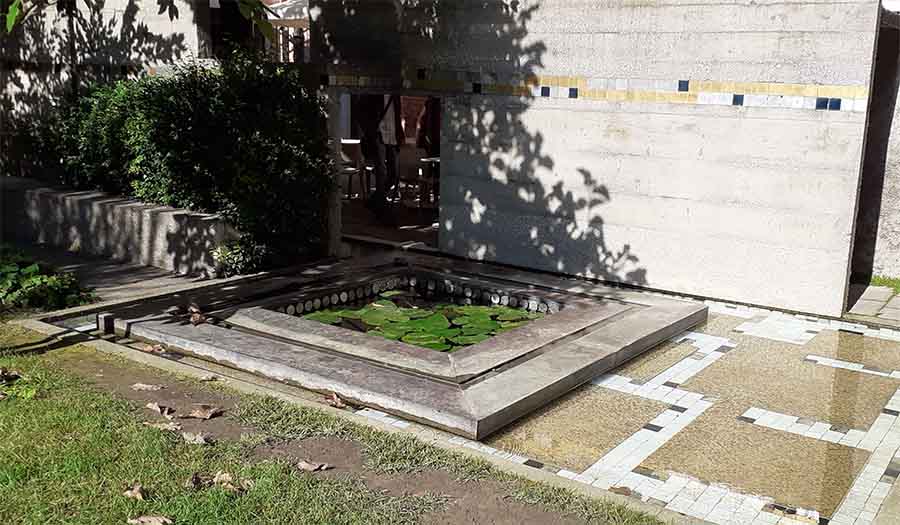This research project, which will form the basis of a forthcoming Leverhulme Trust application, examines the relationships between architecture and nature in the context of the climate crisis. The investigation makes a case that the call for ‘action’ by climatologists and environmentalists in the new climate regime, through the development and implementation of ‘scientific’ solutions to the crisis, is compromised by misguided views of the ‘status’ and meanings of nature and the environment, and the pivotal role of architecture as a mediator (or ‘filter’) for rethinking nature’s tacit (unspoken) presence in human experience.
The research confronts the current debates about the so-called “end of nature”, the bifurcation between nature and culture, and the need to use the human (built) environment as the only viable basis for envisioning the lived and inert world today in all its complexity. The research argues, through a series of thematic studies and detailed building case-studies, that understanding architecture through its temporal, luminous, material and geographic dimensions offers a way forward for re-establishing and securing meaningful experience of the natural world in the new climate regime, preserving in the process the inter-dependent ecologies of the environment and culture.
The project reflects upon the deep traditions and symbolic meanings of nature, and their mimetic relationships to architecture, and how this background provides a useful point of reference for developing an approach to architecture today that is ethically responsive and insightful to the crisis we face.
The research brings together an interdisciplinary team of experts in architectural history, architectural practice, environmental philosophy, cultural geography and sustainability, drawing together different research strands that test a series of hypotheses about the changing relationships between nature and the built environment. These include Professor Nicholas Temple (PI), Dr Thomas Greaves (Senior Lecturer in Philosophy, University of East Anglia), Dr Casper Ebbensgaard (Lecturer in Human Geography, University of East Anglia), Dr Patrick Lynch (Lynch Architects) and Prof. Dean Hawkes (Emeritus Professor of Cardiff University).
The investigation comprises a number of research strands, each involving varying levels of collaboration between researchers and outside institutions. These can be summarised under two key areas:
- Themed studies
- Building Case-Studies
These initial theoretical studies attempt to resituate architecture in the context of nature’s ‘environing’ influence on human dwelling, challenging in the process the conventional definitions and associations of the natural world. An underlying premise of these investigations is that developments in the early modern and modern ages, in particular the impact of technologies of speed (and its compression of time), our expanded horizons of experience (through voyages of discovery, colonisation and ultimately globalisation), and the increasingly estranged relationships between material and its source and origin have profoundly influenced our perception of the ‘natural’ world; from hierarchical symbolic/analogical meanings of depth and ascension (chthonic, terrestrial, celestial) to aesthetic experiences of weathered/illuminated surface or veneer. The investigations are split across the following:
a) Luminosity and Temporality: This examines ways in which temporality is registered architecturally, revealing how assumptions of nature as specifically earth-based (and therefore synonymous with the conditions of biodiversity) need reconsideration through our experience of nocturnal and diurnal shifts in buildings created by solar and earthly movements. >
b) Place and Geography: This explores an emerging field of research — the role and influence of our sense of place on our understanding of nature (Bannon) — examined in the context of architecture. Building on Maurice Merleau-Ponty’s interpretations of nature, the research brings together the writings of Martin Heidegger and Bruno Latour to ascertain the impact of ‘geographically conceived space’ (in the age of evolving globalisation) on our understanding of nature, world and architecture.
c) Materiality, Earth and Building Tectonics: This strand considers the relation between ‘terrain’ and material/tectonic characteristics of buildings, tracing the processes of quarrying and production of building material and its use in fabrication and siting. The study considers the way in which materials in construction comprise varying degrees of ‘natural’ and human-made elements, whose combination and endurance in building fabric serves as a human analogy to the changing biodiversity of the earth. >
d) Language, Building and Nature: This research thread uses Heidegger’s writings on language (including his lecture notes on Herder’s treatise on the origin of language) to explore the entanglements between the nature of language, the ‘natural’ world and building. The investigation demonstrates how understanding of the relationship between architecture and nature depends on the capacity of buildings to serve as living ‘receptacles’ of human exchange.
The second part of the research involves a series of detailed investigations of buildings. These bring together (and synthesise) the findings of the earlier thematic studies, providing a theoretical framework for examining the physical structures, siting and temporal-spatial dimensions of architecture. The case-studies will comprise a range of buildings in both urban and rural contexts (in different regions of the world), and will entail an examination of the conception and design of the buildings, their siting, construction and occupancy or use over time (diurnal, seasonal etc). The investigations will carefully document these buildings and their environmental contexts, revealing in the process the ‘situatedness’ of the spaces of occupancy and how these experiences can invoke different perceptions of nature through everyday activities (sleeping, working, bathing, eating, entertaining, viewing, communicating etc).
An important objective of this research project is to use the findings of the building case studies to develop an ethical framework for architectural practice, demonstrating how architects can be more attuned to the changing ‘natural’ environment and climate through the life of buildings.
Image: Detail of the pool in the gardens of the Fondazione Querini Stampalia by Carlo Scarpa, Venice. Photo by Nicholas Temple.

Project details
Research team
Professor Nicholas Temple
Dr Thomas Greaves, University of East Anglia
Dr Casper Laing Ebbensgaard, University of East Anglia
Dr Patrick Lynch, Lynch Architects
Professor Dean Hawkes, Cardiff University
Project partners
University of East Anglia
Lynch Architects
British School at Rome
Gulbenkian Foundation Lisbon
Research group
Ecological, Architectural and Civic Humanities in Design (EACHiD)
Duration
November 2021 to November 2024
